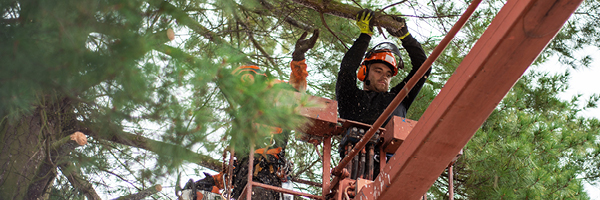
Tree trimming businesses need insurance coverage tailored to their unique needs. Climbing tall trees, operating heavy machinery and dealing with falling debris means it’s critical for those in the business to have the right insurance coverage. One accident could put their whole business at risk.
In this article, we’ll dive deeper into who in the tree care industry needs specialized insurance coverage, the unique risks they face and the insurance coverage they need.
Who needs tree trimming insurance?
Anyone working to trim or remove trees should have specialized insurance coverage.
This includes:
- Tree removal specialists
- Tree trimmers and pruners
- Municipal tree care professionals
- Hardscaping professionals
- Tree pest management specialists
- Landscape and gardening professionals
Remember that even if they’re not cutting down full trees, tree trimming businesses are still at risk of injury and damage. Not having insurance to help cover the cost of damage to a home from a fallen branch can be devastating to a business.
What risks do tree trimming businesses face?
The tree trimming industry carries unique insurance risks. Employees face a higher chance of injury, businesses operate large vehicles that require specialized training and upkeep, and the work often involves a greater risk of property damage.
Severe storms can also trigger sudden spikes in demand, prompting crews to rush jobs and potentially overlook safety protocols—increasing the likelihood of accidents. Additionally, some tree trimming businesses work under contracts with homeowners associations (HOAs), increasing risk due to contractual obligations and the number of residents involved.
It’s important for tree trimming businesses to assess and understand these insurance risks so they can get the right coverage. Here are more in-depth examples of the risks to consider when working on a policy with an agent:
Workers’ Compensation / Injuries
Workers’ compensation risks include:
- Dangerous hand tools (chainsaws, hand saws, loppers and hatchets for example)
- Injury from falling from heights
- Injury from falling branches and debris
- Working on trees around power lines
As mentioned above, tree trimming professionals face a higher risk of injury and death. According to the Tree Care Industry Association (TCIA) and the Bureau of Labor Statistics (BLS), the estimated preliminary fatality rate for tree trimmers and pruners is 110 per 100,000 (FTE) workers. For reference, the all-industry fatal-incident rate is typically between 3.4 to 3.8 per 100,000 FTE.
The BLS estimated non-fatal injury rate for tree workers is 239 injuries per 10,000 workers. The all-industry non-fatal rate is 89 injuries per 10,000 workers — that’s nearly one-third of the injuries for tree workers. Your independent insurance agent can tell you what kind of workers' compensation insurance is required in your state as well as where to purchase it.

Learn about our
Business Insurance
Auto
Tree trimming professionals face auto risks like:
- Driving large trucks or vehicles with specialty operator training requirements
- Issues with load securement
- Possible night driving or poor driving conditions during and after storms
General Liability
General liability risks include:
- Traffic control for tree care professionals working along roadways
- Pedestrian injuries
- Attractive nuisance if equipment is left unattended
- Improper or inadequate subcontractor agreements (For example, subcontractor agreements may not have sufficient risk transfer processes)
Property Damage
Tree trimmers are at higher risk of damaging property through their work. These risks include:
- Debris, limbs or equipment falling on buildings, vehicles or other types of property
- Tree removal affecting underground utilities
- Expensive business equipment being damaged or stolen
Getting the right coverage
Considering the risks tree workers face, it isn’t surprising most tree trimmers aren’t eligible for coverage with most standard carriers due to high-liability work. Tree trimming business owners should consider the following when discussing coverage options:
- General liability coverage to cover third-party injury or property damage
- Workers’ compensation coverage to protect injured employees and the business
- Commercial auto coverage to cover work trucks, trailers and other vehicles
- Inland marine coverage for tools and equipment transported between sites
- Professional liability coverage, also known as errors and omissions insurance, covers claims related to advice or services provided like tree assessments or consultations
Taking all of this into account, tree trimming can be dangerous, and the right insurance policy is essential. We know it can be overwhelming trying to find the right coverage. Our independent insurance agents can help. If you’re a tree trimming business owner, find an agent today to start discussing your business needs and make sure you, your employees and your business are protected before the next job begins.
References
-
Tree Care Industry Association
-
Trusted Choice
-
American Climbers
Coverages described herein may not be available in all states. Please contact a local independent Integrity agent for complete details on coverages and discounts. If the policy coverage descriptions herein conflict with the language in the policy, the language in the policy applies. The material provided above is for informational, educational, or suggestion purposes and does not imply coverage. WE RESERVE THE RIGHT TO REFUSE TO QUOTE ANY INDIVIDUAL PREMIUM RATE FOR THE INSURANCE HEREIN ADVERTISED. Integrity Insurance policies are underwritten by Integrity Insurance Company, an affiliate of Grange Insurance Company, and Integrity’s subsidiaries. Integrity companies not licensed in Pennsylvania. Not all Integrity companies are licensed in all states.